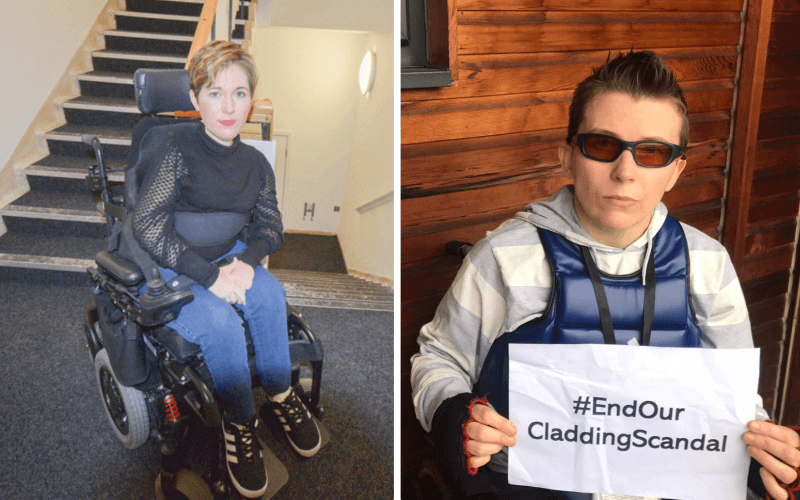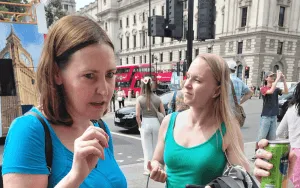Disabled people who lease their own flats in high-rise buildings have been left frightened for their lives, but also in fear of losing their homes, because of the government’s failure to address the growing post-Grenfell safety scandal.
A new campaign group, co-founded by two disabled leaseholders, called on the government this week to address the “very distressing” financial pressures and safety concerns that thousands of disabled leaseholders are facing.
In a letter to housing secretary Robert Jenrick, Georgie Hulme and Sarah Rennie say that they and other disabled leaseholders are experiencing an “unjust” series of concerns.
They say the government is failing to address these concerns, which have emerged in the months and years following the Grenfell Tower fire, on 14 June 2017, which led to the loss of 72 lives, including disabled residents who died after public bodies failed to plan how they would evacuate their homes in the event of a fire.
The new CladDAG leaseholder disability action group was formed only last month, and aims to raise awareness of the “additional and multiple ways disabled leaseholders are impacted by this scandal”.
In their letter, they say they “live in fear” of being abandoned and left to die if there is a fire, as happened to disabled Grenfell residents, because their buildings do not meet fire safety standards.
But they also point to the “escalating costs” that many leaseholders are facing because of the government’s refusal to fund vital safety work, such as replacing flammable cladding and fixing other fire safety flaws, and rocketing insurance costs.
They are particularly alarmed at reports that the government is considering asking many flat owners to take out 30-year loans to pay for the cost of fixing fire safety issues and avoid “burdening tax-payers”, rather than asking developers, builders and freeholders to meet the costs.
And they say the government’s decision only to support residents of buildings above 18 metres in height (about six or seven storeys) through its £1 billion Building Safety Fund – which will help fund the removal of dangerous cladding – will disproportionately affect disabled people, who are more likely to live in lower-height buildings.
They say in the letter: “Many disabled leaseholders have invested thousands of pounds in making their homes accessible, eg installing wetrooms, lowered kitchens, intercoms etc.
“Our ‘homes for life’ are now at risk.”
Rennie (pictured, left, in her building) moved into her wheelchair-accessible, 13th-floor Birmingham flat in 2008 and is supported by a 24-hour care package.
Yesterday, she received a bill of more than £52,000 for her share of the removal of cladding from her building, in addition to a huge increase in the annual service charge, which means she will need to pay another £5,000.
She said last night (Wednesday): “When I saw the first bill I had to read it a few times to take it in. I laughed in disbelief. Now I just feel a bit numb.”
She has already spent much of her life savings making adaptations, with help from a disabled facilities grant from her local council, because, she says, it is her “home for life”.
She told Disability News Service: “It meant a lot to me and my family to know I’d have somewhere safe to live when I’m no longer able to work.
“Now I’m looking at potentially tens of thousands of pounds to fix the building’s problems and, if we don’t get grant funding for the cladding, the bill for the block will run into millions.
“On top of this, I’m terrified about evacuation.
“We recently heard that, due to issues with the lift shaft, neither residents nor the fire service can use the lift in an emergency.”
She said: “I used to be so happy, living in a safe flat for me and personal assistants and had a plan with the fire service to use the lift – now I discover that I live in a building wrapped in flammable cladding and my evacuation plan has been torn up.
“I feel let down by government, betrayed by developers I dealt with in good faith and frightened for my safety.”
Although her building is above 18 metres, she and her fellow lease-holders do not know if their application for a grant from the Building Safety Fund will be successful or if any grant they do secure will cover the full costs of cladding removal.
She added: “The fund is nowhere near enough to go around all the buildings who are eligible.
“In any event, the grants do not cover knock-on costs such as insurance (our premiums have skyrocketed).”
Hulme (pictured, right, on her balcony), also a wheelchair-user, lives on the third floor of a building in Hulme, Manchester, which has been found to have major fire risks, including with the cladding, as well as unsafe materials on the balconies.
She said: “It was built unsafe. The developers went bankrupt, so we have no recourse to challenge them.”
Her block is about a metre shorter than the minimum for funding from the Building Safety Fund, but she and her fellow lease-holders are still applying because part of the building is above 18 metres, although they are not hopeful of securing a share of the £1 billion.
She said: “I really love my flat, the location and the community, but I am stuck in a building that’s extremely unsafe, with no options.
“My mum died in the comfort of thinking that she’d left me with home security for life, in an accessible flat that I love. It’s heart-breaking that this isn’t the case.
“It’s also impacting on my health – I was recently hospitalised and unresponsive for 12 hours, which my consultants put down to stress.
“I am no longer able to work due to my complex needs, so I’m reliant on state benefits, which means it’s unfeasible for me to pay such a huge amount of money or access credit for such sums.
“This housing scandal is an injustice of immeasurable proportions and the government is not dealing with it fairly.”
Hulme and Rennie are already set for a virtual meeting with Vicky Foxcroft, Labour’s shadow minister for disabled people, and have asked in their letter to meet Jenrick.
Foxcroft said this week: “Every person has a right to feel safe in their own home; the concerns raised by disabled leaseholders are very worrying.
“Lessons must be learnt from Grenfell; the government needs to ensure proper fire safety is in place as a matter of urgency so disabled people are clear that they will be evacuated safely.”
An MHCLG spokesperson said: “We understand many people feel helpless which is why our priority is to remove unsafe materials as quickly as possible – backed by £1.6 billion of funding.
“Building owners should make all buildings safe without passing on costs to leaseholders where possible – as has happened with more than half of the private sector buildings with ACM* cladding.
“We are considering a range of options to fund future remediation work on high-rise buildings.
“We continue to work with a range of stakeholders, including leaseholders and the finance industry. Further details will be set out in due course.”
MHCLG said that about 95 per cent of the highest risk buildings identified at the start of last year now have safety work completed or underway.
*Aluminium composite material, the kind used on Grenfell and blamed by the inquiry for being the primary cause of the fire spreading
A note from the editor:
Please consider making a voluntary financial contribution to support the work of DNS and allow it to continue producing independent, carefully-researched news stories that focus on the lives and rights of disabled people and their user-led organisations.
Please do not contribute if you cannot afford to do so, and please note that DNS is not a charity. It is run and owned by disabled journalist John Pring and has been from its launch in April 2009.
Thank you for anything you can do to support the work of DNS…

 Disabled MP who quit government over benefit cuts tells DNS: ‘The consequences will be devastating’
Disabled MP who quit government over benefit cuts tells DNS: ‘The consequences will be devastating’ Absence of disabled people’s voices from assisted dying bill has been ‘astonishing’, says disabled MP
Absence of disabled people’s voices from assisted dying bill has been ‘astonishing’, says disabled MP ‘Real danger’ that disabled people will not benefit from £39 billion for social and affordable homes
‘Real danger’ that disabled people will not benefit from £39 billion for social and affordable homes